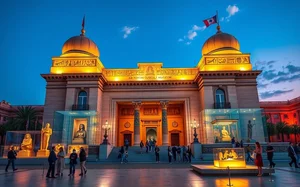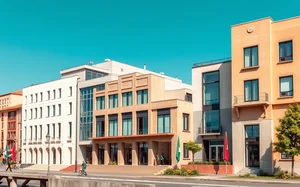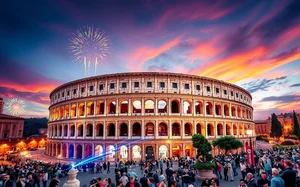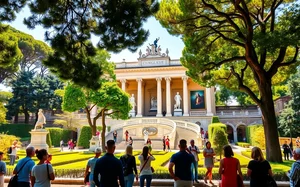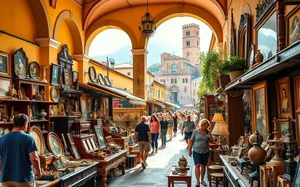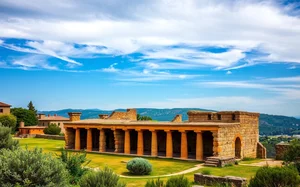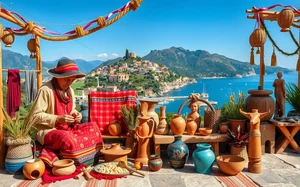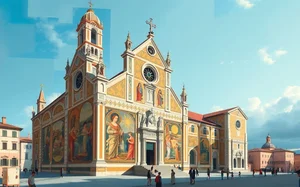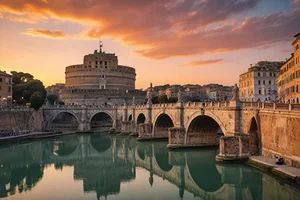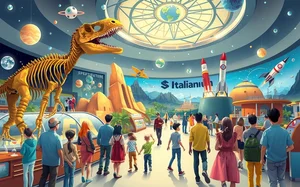Book your experience
If you think that Italy is only art and history, it’s time to discover an unexpected side of the Bel Paese: Rationalist Architecture. This movement, which took hold in the 20th century, has left an indelible mark on our urban landscape, with buildings that combine functionality and aesthetics in perfect balance. Walking through the streets of cities such as Rome and Milan, tourists can admire iconic structures that tell stories of innovation and modernity. A journey through Rationalism is not just a visual experience, but an immersion in a fascinating chapter of Italian culture. Get ready to explore an architectural heritage that defies time and invites you to reflect on the future.
Icons of Milan: rationalist architecture in the city
Milan, one of the world capitals of design, is an extraordinary stage for rationalist architecture. Walking through its streets, it is easy to come across buildings that tell stories of innovation and functionality. The Palazzo della Civiltà Italiana, with its clean and geometric lines, is an emblematic example of how rationalism can blend aesthetics and practicality.
We cannot forget the Teatro alla Scala, which, despite its fame as a temple of opera, hides a rationalist façade that deserves attention. The choice of modern materials and the use of simple shapes reflect the desire for a new era.
To discover these masterpieces, a recommended itinerary is the Porta Nuova District, where skyscrapers and public spaces integrate perfectly, demonstrating how rationalism continues to influence contemporary architecture. Don’t forget to visit the Pirelli Skyscraper, an icon that has left its mark on the Milanese skyline.
For tourists looking for a deeper experience, it is useful to join specialized guided tours, where local experts can reveal the secrets and stories behind these monuments. Make sure you bring a camera with you: every corner of Milan is an opportunity to immortalize the beauty of rationalist architecture, making your trip not only a visual experience, but also an indelible memory.
Rome and Rationalism: a surprising tour
Rome, the eternal city, is not only the guardian of classical works, but also a stage for rationalist architecture. This style, which emerged between the two world wars, left an indelible mark on the urban fabric of the capital. Walking through the avenues of Rome, you come across buildings that tell a story of innovation and functionality.
One of the most representative symbols is the Palazzo della Civiltà Italiana, also known as the “Square Colosseum”. Its geometric lines and elegant porticoes express an idea of order and rationality, which is also reflected in the materials used, such as travertine. Continuing into the EUR district, you can discover other architectural gems such as the Ministry of Communications and the Palazzo della Civiltà del Lavoro, both brilliant examples of how rationalism can blend with the historical context.
For photography lovers, a tour of Roman rationalism offers countless ideas. Don’t forget to visit the Teatro dei Dioscuri, a place where sculptural forms and clean lines create a unique atmosphere.
For a complete experience, we recommend planning your visit during the week, avoiding crowded weekends, and bringing a camera with you to capture every architectural detail. The discovery of rationalism in Rome is not just a journey through time, but an opportunity to observe how design can influence our way of living and perceiving the city.
Functionality and design: a perfect balance
At the heart of Italian rationalist architecture lies a fundamental principle: the harmony between functionality and design. This style, which emerged in the 1920s and 1930s, not only redefined the aesthetic lines of buildings, but also revolutionized the way we think about living and working spaces.
Let’s take for example the famous Palazzo della Civiltà Italiana in Rome, which perfectly embodies the concept of rationalism. Its geometric shapes and imposing façade are not only a tribute to aesthetics, but reflect a clear intention of functionality. Every window, every corner is designed to maximize natural light and promote the liveability of the internal spaces.
In Milan, the Pirelli Skyscraper represents another symbol of this balance. Its slender structure is not only a masterpiece of design, but is also an example of energy efficiency, with innovative solutions that optimize resource consumption.
For those who wish to explore this fusion between aesthetics and practicality, it is advisable to also visit the lesser-known neighborhoods, where the small rationalist buildings tell stories of innovation. Don’t forget to bring your camera: every corner offers unique ideas for capturing the essence of an architecture that continues to influence contemporary design.
Immersing yourself in the world of rationalism is a way to understand not only architectural history, but also the profound connection between form and function, an aspect that makes every visit a memorable experience.
Historic buildings: evidence of innovation
Italian rationalist architecture has left an indelible mark on the urban landscape, and the historic buildings are its true testimonies of innovation. Walking through the streets of cities like Milan and Rome, you come across structures that not only tell a story, but embody an era of great planning and social fervor.
One of the most emblematic examples is the Palazzo della Civiltà Italiana in Rome, also known as the Square Colosseum. This monument, with its clean and geometric lines, represents the essence of rationalism, combining functionality and beauty in a harmonious way. In Milan, the Pirelli Skyscraper stands majestically, a symbol of a modernity that looks to the future, with its glass facade that reflects the sky and the city below.
Visiting these buildings is not just a visual experience; it is a journey through time that invites us to reflect on how architecture can influence daily life. For those who wish to delve deeper into this topic, it is recommended to take part in specialized guided tours which offer a historical and cultural context, making every detail even more fascinating.
Don’t forget to bring a camera with you: every corner of these historic buildings offers unique ideas for unforgettable shots. Discovering rationalism through these works means, in fact, immersing yourself in a dialogue between past and future that continues to inspire.
Discovering Rationalism in small villages
Rationalist architecture is not only a prerogative of large Italian cities; the small villages hold authentic gems that tell stories of innovation and modernity. Walking through the streets of places like Cernobbio or Colonnata, you can discover buildings that embody the essence of rationalism, characterized by clean lines and functionality.
Take for example Cernobbio, on Lake Como, where the Villino Morsia stands with its elegant design, perfectly integrated into the landscape. Its simple but charming facade is a clear homage to rationalist philosophy, which favors “less is more”. Here, architecture becomes an extension of the surrounding natural beauty.
Another example is Colonnata, renowned for its marble quarries and the Rationalist Architecture Study Centre. This small village offers a tour that explores historic buildings renovated according to the principles of rationalism, inviting visitors to reflect on the dialogue between tradition and modernity.
For those who want to immerse themselves in this fascinating size, we suggest planning a visit in spring or autumn, when the climate is ideal for walking. Don’t forget your camera: geometric lines and open spaces are perfect for capturing the essence of rationalism. Discovering rationalist architecture in small villages is a unique way to appreciate the cultural and historical richness of Italy.
Museums and galleries: exploring contemporary art
Milan, considered the capital of art and design, is a perfect stage to discover how rationalist architecture has influenced contemporary art. Walking through the streets of the city, you come across exhibition spaces that not only host works of art, but also tell a story of innovation and functionality.
An emblematic example is the Museo del Novecento, where the clean and geometric lines of the building reflect the principles of rationalism. Here, spectators can admire masterpieces by artists such as Boccioni and De Chirico, immersed in an environment that celebrates the harmony between art and architecture. Not far away, the PAC (Pavilion of Contemporary Art) stands out for its modern structure, which hosts temporary exhibitions of emerging and established artists, offering a continuous dialogue between past and present.
But Milan is not the only city where rationalist architecture meets art: in Rome, the MAXXI stands as a symbol of innovation, designed by Zaha Hadid, fusing exhibition spaces with bold lines and dynamic curves.
For a complete experience, book a guided tour of the main museums and galleries, where experts will lead you through unexpected paths, revealing the links between architecture and works of art. Don’t forget to bring your camera to capture the essence of these extraordinary structures!
Rationalist architecture and sustainable tourism
Italian rationalist architecture is not just a triumph of clean lines and geometric shapes; it is also an example of sustainability and functionality that can inspire a new way of travelling. In an era where responsible tourism is more important than ever, rationalist works offer a vision of how architecture can integrate harmoniously with the environment.
In Milan, for example, the Palazzo della Civiltà Italiana, also known as the Square Colosseum, is a symbol of elegance and simplicity, but also represents a design intent that considers the efficient use of resources. Visiting buildings like this allows tourists to reflect on the importance of an architecture that does not exploit the territory, but enhances it.
Furthermore, rationalism encourages tourism that respects cultural heritage. Through guided small group tours, visitors can explore historic neighborhoods, such as the Città Studi neighborhood in Milan, where each building tells a story of innovation.
Let’s not forget the importance of ecological transport: using the bicycle or public transport to reach these monuments reduces the environmental impact and offers a unique perspective on the city.
In conclusion, rationalist architecture is not just a journey into the past, but an invitation to reflect on a more sustainable future. Join us to discover how design can inspire responsible and conscious tourism.
Events and festivals: celebrating modernity
Italian rationalist architecture is not just a question of buildings; it is a cultural movement that is celebrated through events and festivals throughout Italy. These events offer the opportunity to immerse yourself in the aesthetics and philosophy of rationalism, creating a profound link between past and present.
Every year, Milan hosts the “Architecture Festival”, an event that brings together architects, designers and enthusiasts to discuss and showcase innovations in the field of design and architecture. During this festival, visitors can participate in guided tours that explore some of the most significant rationalist icons, such as the Palazzo della Civiltà Italiana and the Pirelli Skyscraper. These buildings not only represent an era, but are also a stage for temporary exhibitions and art installations.
In Rome, “Razionalismo in Festa” celebrates the legacy of architects such as Giuseppe Terragni, with events including conferences, film screenings and guided tours of iconic structures such as the Villino delle Fate. These events offer participants the opportunity to learn directly from experts and to share the passion for an architecture that has been able to combine functionality and beauty.
Attending these festivals is not just a way to explore rationalist architecture; it is an immersive experience that stimulates reflection on modernity and its impact on our daily lives. Don’t forget to bring your camera to capture these architectural wonders in their festive context!
An alternative route: bikes and architecture
Discovering Italian rationalist architecture by bike is a unique and engaging way to experience the city. Imagine cycling through the streets of Milan, where masterpieces of modern architecture stand out like monuments of an innovative era. Every curve and every intersection will bring you into contact with emblematic buildings, such as the Palazzo della Civiltà Italiana and the Pirelli Skyscraper, icons of functional and bold design.
While tackling the route, you can stop in the various rationalist neighborhoods that dot the city, such as the Quartiere Libia or the Villaggio dei Giornalisti. Here, your gaze will be captured by the clean lines and modern materials that characterize these structures. The bicycles, with their silence, will allow you to savor every detail, from the harmonious layout of the spaces to the innovative use of natural light.
Don’t forget to bring a map of architectural attractions; many of them, such as the National Theater or the Palazzo delle Poste, are easily reachable by bicycle. Furthermore, you could organize a picnic in the surrounding parks, such as Parco Sempione, to recharge your batteries and reflect on the impact of rationalism on contemporary architecture.
This alternative route will not only enrich your trip, but will also contribute to sustainable tourism, allowing you to explore the beauty of Italian cities in an eco-friendly way.
Advice for photographers: capturing Rationalism
Capturing the essence of Italian rationalist architecture through the lens of a camera is an experience that combines art and technique. Rationalist buildings, with their clean lines and geometric shapes, offer unique photographic opportunities that tell stories of innovation and modernity.
Begin your photographic adventure in Milan, where the Palazzo della Civiltà Italiana and the Casa della Musica stand out against the sky, exemplifying the beauty of rationalism. Take advantage of the morning light to capture the reflections of the glass and steel facades, which create a fascinating play of shadows and lights.
When you travel to Rome, don’t forget to visit the Villino delle Fate and the Palazzo della Civiltà del Lavoro. Here, the symmetry and functionality of the buildings offer countless angles for framing extraordinary shots. Consider using a wide-angle lens to emphasize the monumental proportions and scale of the spaces.
To get truly evocative shots, look for architectural details like windows, doors and geometric decorations. The beauty of Rationalism also lies in the details, which describe the design thinking of an era.
Finally, plan your photography trips based on the conditions of light. The golden hour, just before sunset, can transform even the most austere building into a work of art. Equip yourself with patience and creativity: rationalist architecture is just waiting to be immortalized.


 Architecture and Design
Architecture and Design Cities and Regions
Cities and Regions Culture and History
Culture and History Events and Festivals
Events and Festivals Fashion and Shopping
Fashion and Shopping Food and Wine
Food and Wine Nature and Adventure
Nature and Adventure Unique Experiences
Unique Experiences